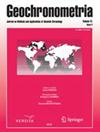Variation of OSL residual doses in terms of coarse and fine grain modern sediments along the Hungarian section of the Danube
IF 0.9
4区 地球科学
Q3 Earth and Planetary Sciences
引用次数: 13
Abstract
Abstract Reliable OSL dating of fluvial sediments requires an assessment of incomplete bleaching and consequent residual dose in samples. A well-established way of this is determining the equivalent dose of modern samples from similar sedimentary environments as in the case of palaeo-samples. Meanwhile, relatively low, or close to zero doses are also greatly affected by the thermal transfer phenomenon, which can also lead to a palaeodose overestimation. The present study attempts to quantify both factors in coarse and fine grain modern sediments along the Hungarian section of the Danube River, with the aim of determining their significance when dating both young and palaeo-sediments. Investigations were performed at 30 sites along a 417 km long river section with varying morphological and erosive character. The studied samples were deposited during the record flood of 2013, mobilising and relocating a vast amount of sediment in the system. Tests have shown that thermal transfer can be minimized successfully by choosing preheat temperatures below 200°C, however it remains a significant factor when dating young or modern sediments. Based on equivalent dose measurements, coarse grain samples proved to be relatively well bleached, and residual doses showed only a minor spatial variation. Although in terms of fine grain samples residual doses were obviously much higher, results can enhance the reliability of dates retrieved later from fine grain palaeo-samples. In the meantime, the higher spatial variability of fine grain residual doses may also allow the assessment of the erosive character of different river reaches.多瑙河匈牙利段粗粒和细粒现代沉积物中OSL残留剂量的变化
摘要河流沉积物的可靠OSL年代测定需要评估样品中的不完全漂白和由此产生的残留剂量。一种公认的方法是确定来自类似沉积环境的现代样品的等效剂量,就像古样品一样。同时,相对较低或接近零的剂量也受到热传递现象的极大影响,这也可能导致古剂量的高估。本研究试图量化多瑙河匈牙利段粗粒和细粒现代沉积物中的这两个因素,目的是确定它们在确定年轻沉积物和古沉积物年代时的意义。在417公里长的河段上的30个地点进行了调查,这些河段具有不同的形态和侵蚀特征。所研究的样本是在2013年创纪录的洪水期间沉积的,调动和重新定位了系统中的大量沉积物。测试表明,通过选择低于200°C的预热温度,可以成功地将热传递降至最低,但在确定年轻或现代沉积物的年代时,这仍然是一个重要因素。根据等效剂量测量,粗粒样品被证明是相对良好的漂白,残留剂量仅显示出微小的空间变化。尽管就细粒样品而言,残留剂量明显高得多,但结果可以提高后来从细粒古样品中检索到的日期的可靠性。同时,细粒残留剂量的较高空间变异性也可以评估不同河段的侵蚀特性。
本文章由计算机程序翻译,如有差异,请以英文原文为准。
求助全文
约1分钟内获得全文
求助全文
来源期刊

Geochronometria
地学-地球科学综合
CiteScore
2.20
自引率
0.00%
发文量
1
审稿时长
>12 weeks
期刊介绍:
Geochronometria is aimed at integrating scientists developing different methods of absolute chronology and using them in different fields of earth and other natural sciences and archaeology. The methods in use are e.g. radiocarbon, stable isotopes, isotopes of natural decay series, optically stimulated luminescence, thermoluminescence, EPR/ESR, dendrochronology, varve chronology. The journal publishes papers that are devoted to developing the dating methods as well as studies concentrating on their applications in geology, palaeoclimatology, palaeobiology, palaeohydrology, geocgraphy and archaeology etc.
 求助内容:
求助内容: 应助结果提醒方式:
应助结果提醒方式:


